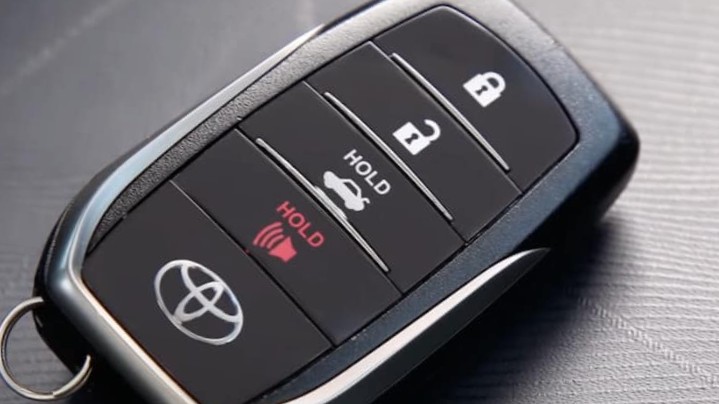Key fobs have become an indispensable part of modern car ownership, offering unparalleled convenience and security compared to traditional keys. These little devices use radio frequency identification (RFID) to effortlessly lock, unlock, and even start your Toyota vehicle remotely. However, like any battery-powered device, your Toyota key fob relies on a battery that will eventually need replacing. A dead key fob battery can be more than just an inconvenience; it can leave you stranded when you least expect it.
Fortunately, changing the battery in your Toyota key fob is a straightforward process you can easily handle at home. This guide from the experts at keyfobx.com will walk you through each step, ensuring you can quickly and efficiently get your key fob back in working order. We’ll cover everything from identifying the signs of a low battery to the exact steps for replacement, empowering you to tackle this simple maintenance task yourself.
Step-by-Step Guide to Toyota Key Fob Battery Replacement
Knowing how to change your Toyota key fob battery is a valuable skill for any car owner. It saves you time and money compared to visiting a dealership for a simple battery replacement. Follow these easy steps to get your key fob working like new.
1. Gather Your Tools and Supplies
Before you begin, you’ll need to gather a few simple tools:
- A new CR2032 battery: This is the most common type of battery used in Toyota key fobs. You can find these at most drugstores, big-box retailers, and online. It’s always a good idea to double-check your owner’s manual or the old battery to confirm the correct type.
- A small flat-head screwdriver or the emergency key from your key fob: This will be used to open the key fob casing. For some newer Toyota models, the emergency key itself is designed to open the fob.
- A soft cloth (optional): To protect the key fob casing from scratches.
2. Remove the Emergency Key
Most Toyota key fobs have a mechanical emergency key hidden inside. Locate the small release button on your key fob – it’s usually a small metal or plastic button. Press and hold this button to release the emergency key. Slide the key out and set it aside. You may need this key to open the car door manually if your key fob is completely dead.
 Toyota key fob on a white background, showcasing the location of the emergency key release button.
Toyota key fob on a white background, showcasing the location of the emergency key release button.
3. Open the Key Fob Casing
The method for opening your Toyota key fob case varies slightly depending on the model and year of your vehicle.
- For Newer Toyota Models: Look for a small slot or notch on the side of the key fob casing, often where the emergency key was housed. Insert the end of the emergency key blade into this slot. Gently twist or lever the key to pry the two halves of the key fob casing apart.
- For Older Toyota Models: If you don’t see a dedicated slot for the emergency key, look for a small notch along the seam of the key fob casing. Use a small flat-head screwdriver, carefully inserted into this notch, to gently pry the case open. Be cautious not to apply too much force, as you could damage the plastic casing. Using a soft cloth around the screwdriver tip can help prevent scratches.
4. Access and Remove the Old Battery
Once the key fob is open, carefully separate the two halves of the casing. You’ll see the internal components, including a small circuit board and the battery compartment. The battery is usually a small, round, silver disc battery (CR2032).
Take note of the battery’s orientation – specifically, which side is facing up (+ or -). This is important for installing the new battery correctly. Gently pry the old battery out of its compartment. You can often use your fingertip or the edge of the small screwdriver to carefully lift it out.
5. Install the New CR2032 Battery
Take your new CR2032 battery and insert it into the battery compartment. Ensure you are placing it in the correct orientation, matching the polarity of the old battery. Usually, the positive (+) side of the battery should be facing upwards, but double-check the markings in the battery compartment if you are unsure. Press down gently until the battery is securely seated in the compartment.
6. Reassemble the Key Fob
Carefully align the two halves of the key fob casing and snap them back together. Ensure the case is fully closed and secure, with no gaps. You should hear a click as the two halves join properly.
7. Test Your Toyota Key Fob
After reassembling the key fob, it’s crucial to test it to ensure the battery replacement was successful.
- Unlock and Lock Doors: Try unlocking and locking your Toyota doors using the key fob buttons.
- Test Remote Start (if applicable): If your Toyota model has remote start functionality, test this feature.
- Check the Panic Button: Press the panic button to ensure the alarm system is working correctly.
If your key fob responds to these commands, congratulations! You have successfully changed your Toyota key fob battery. If it doesn’t work, double-check that the battery is installed correctly with the right polarity, and that the casing is fully closed.
Signs Your Toyota Key Fob Battery Needs Replacing
Being proactive about replacing your key fob battery can prevent unexpected inconveniences. Here are some common signs that indicate your Toyota key fob battery is getting weak and needs replacement:
- Reduced Range: You need to be closer to your Toyota than usual for the key fob to work. If you notice you have to press the buttons multiple times or stand right next to the car for it to respond, the battery is likely weakening.
- Dim or No Light on the Key Fob: Many key fobs have an indicator light that illuminates when you press a button. If this light is dim, weak, or doesn’t light up at all, it’s a strong sign of a low battery.
- Sluggish Response: There’s a noticeable delay between pressing a button on your key fob and your car responding. A healthy key fob should provide an almost instantaneous response.
- Dashboard Warning Light: Some newer Toyota models may display a warning message or key symbol on the dashboard indicating a low key fob battery. Refer to your owner’s manual for details on specific warnings for your vehicle.
What If Changing the Battery Doesn’t Fix the Problem?
In most cases, replacing the battery will resolve key fob issues. However, if you’ve replaced the battery and your Toyota key fob still isn’t working, there might be other underlying problems.
- Key Fob Damage: Inspect your key fob for any signs of physical damage, such as cracks, water damage, or broken buttons. Damage to the internal components can prevent the key fob from working even with a new battery.
- Key Fob Programming Issues: In rare cases, the key fob may lose its programming and need to be reprogrammed to your vehicle.
- Vehicle Receiver Problems: Although less common, the issue could be with the receiver in your Toyota that communicates with the key fob.
If you suspect any of these more complex issues, or if you prefer professional assistance, the service experts at your local Toyota dealership or a trusted automotive service center can diagnose and resolve the problem. They can test your key fob, check for programming issues, and determine if a replacement key fob is necessary.
Changing your Toyota key fob battery is a simple maintenance task that can save you from being locked out or stranded. By following this guide and recognizing the signs of a weak battery, you can keep your key fob working reliably and enjoy the convenience it offers.
